IL-12 Expressing oncolytic herpes simplex virus promotes anti-tumor activity and immunologic control of metastatic ovarian cancer in mice
- PMID: 27784340
- PMCID: PMC5082415
- DOI: 10.1186/s13048-016-0282-3
IL-12 Expressing oncolytic herpes simplex virus promotes anti-tumor activity and immunologic control of metastatic ovarian cancer in mice
Abstract
Background: Despite advances in surgical aggressiveness and conventional chemotherapy, ovarian cancer remains the most lethal cause of gynecologic cancer mortality; consequently there is a need for new therapeutic agents and innovative treatment paradigms for the treatment of ovarian cancer. Several studies have demonstrated that ovarian cancer is an immunogenic disease and immunotherapy represents a promising and novel approach that has not been completely evaluated in ovarian cancer. Our objective was to evaluate the anti-tumor activity of an oncolytic herpes simplex virus "armed" with murine interleukin-12 and its ability to elicit tumor-specific immune responses. We evaluated the ability of interleukin-12-expressing and control oncolytic herpes simplex virus to kill murine and human ovarian cancer cell lines in vitro. We also administered interleukin-12-expressing oncolytic herpes simplex virus to the peritoneal cavity of mice that had developed spontaneous, metastatic ovarian cancer and determined overall survival and tumor burden at 95 days. We used flow cytometry to quantify the tumor antigen-specific CD8+ T cell response in the omentum and peritoneal cavity.
Results: All ovarian cancer cell lines demonstrated susceptibility to oncolytic herpes simplex virus in vitro. Compared to controls, mice treated with interleukin-12-expressing oncolytic herpes simplex virus demonstrated a more robust tumor antigen-specific CD8+ T-cell immune response in the omentum (471.6 cells vs 33.1 cells; p = 0.02) and peritoneal cavity (962.3 cells vs 179.5 cells; p = 0.05). Compared to controls, mice treated with interleukin-12-expressing oncolytic herpes simplex virus were more likely to control ovarian cancer metastases (81.2 % vs 18.2 %; p = 0.008) and had a significantly longer overall survival (p = 0.02). Finally, five of 6 mice treated with interleukin-12-expressing oHSV had no evidence of metastatic tumor when euthanized at 6 months, compared to two of 4 mice treated with sterile phosphate buffer solution.
Conclusion: Our pilot study demonstrates that an interleukin-12-expressing oncolytic herpes simplex virus effectively kills both murine and human ovarian cancer cell lines and promotes tumor antigen-specific CD8+ T-cell responses in the peritoneal cavity and omentum, leading to reduced peritoneal metastasis and improved survival in a mouse model.
Keywords: Immunotherapy for treatment of ovarian cancer; Oncolytic herpes simplex virus.
Figures
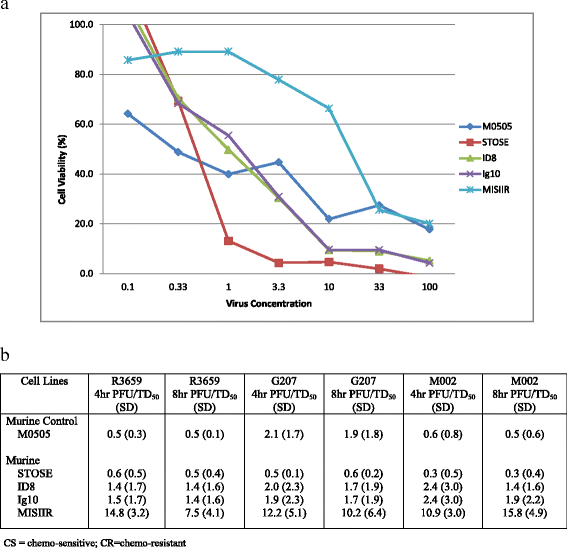
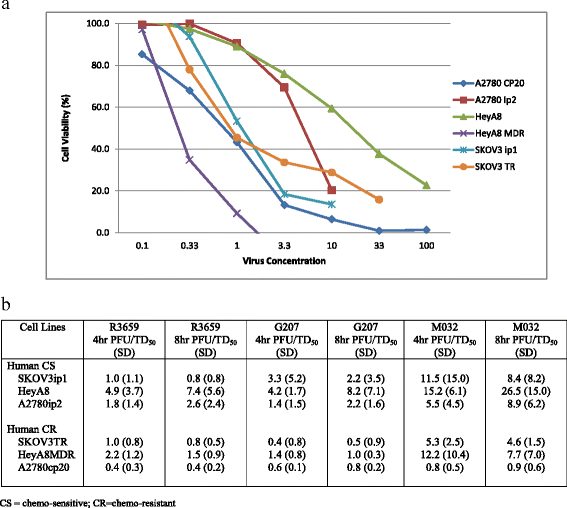
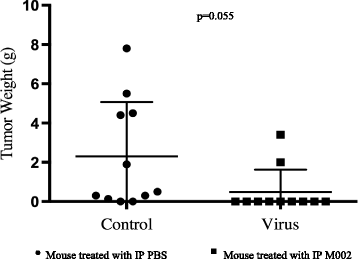
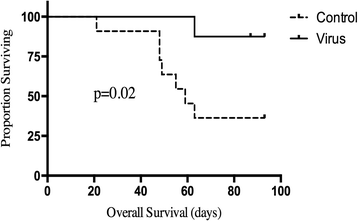
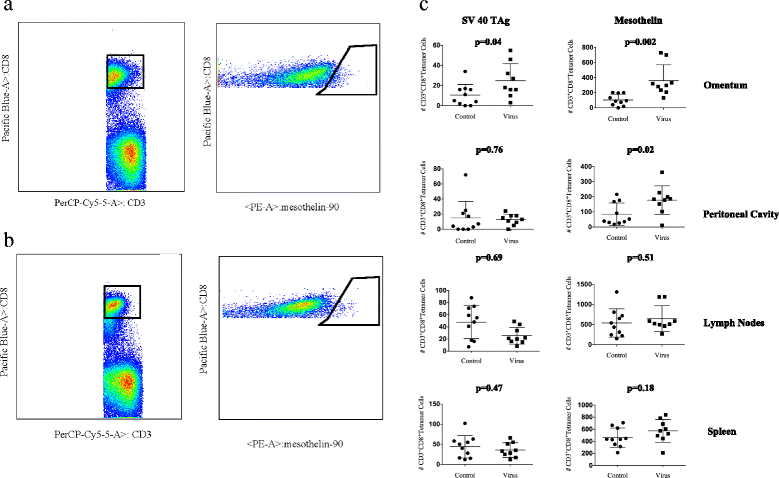
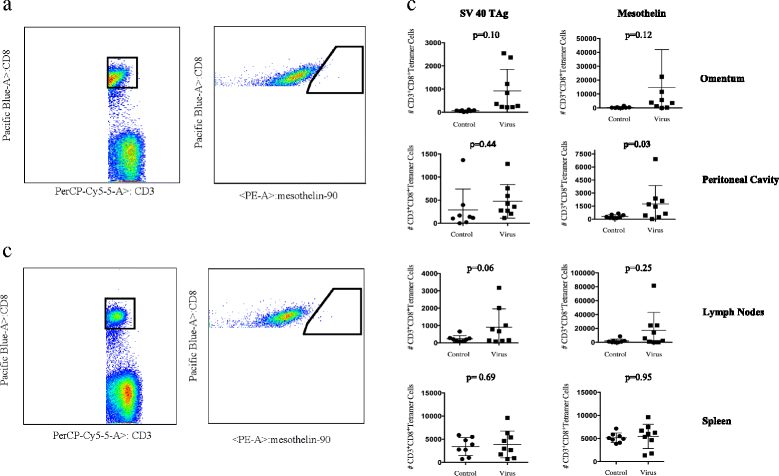
Similar articles
-
Doxorubicin synergizes with 34.5ENVE to enhance antitumor efficacy against metastatic ovarian cancer.Clin Cancer Res. 2014 Dec 15;20(24):6479-94. doi: 10.1158/1078-0432.CCR-14-0463. Epub 2014 Oct 7. Clin Cancer Res. 2014. PMID: 25294909 Free PMC article.
-
Preclinical therapy of disseminated HER-2⁺ ovarian and breast carcinomas with a HER-2-retargeted oncolytic herpesvirus.PLoS Pathog. 2013 Jan;9(1):e1003155. doi: 10.1371/journal.ppat.1003155. Epub 2013 Jan 31. PLoS Pathog. 2013. PMID: 23382683 Free PMC article.
-
Development of a new fusion-enhanced oncolytic immunotherapy platform based on herpes simplex virus type 1.J Immunother Cancer. 2019 Aug 10;7(1):214. doi: 10.1186/s40425-019-0682-1. J Immunother Cancer. 2019. PMID: 31399043 Free PMC article.
-
Oncolytic virus therapy using genetically engineered herpes simplex viruses.Front Biosci. 2008 Jan 1;13:2060-4. doi: 10.2741/2823. Front Biosci. 2008. PMID: 17981691 Review.
-
Advance in herpes simplex viruses for cancer therapy.Sci China Life Sci. 2013 Apr;56(4):298-305. doi: 10.1007/s11427-013-4466-4. Epub 2013 Apr 7. Sci China Life Sci. 2013. PMID: 23564184 Review.
Cited by
-
The Ectopic Expression of SurvivinT34A and FilC Can Enhance the Oncolytic Effects of Vaccinia Virus in Murine Gastric Cancer.Onco Targets Ther. 2020 Feb 3;13:1011-1025. doi: 10.2147/OTT.S230902. eCollection 2020. Onco Targets Ther. 2020. PMID: 32099404 Free PMC article.
-
Tune Up In Situ Autovaccination against Solid Tumors with Oncolytic Viruses.Cancers (Basel). 2018 May 31;10(6):171. doi: 10.3390/cancers10060171. Cancers (Basel). 2018. PMID: 29857493 Free PMC article. Review.
-
Intratumoral expression of IL-12 from lentiviral or RNA vectors acts synergistically with TLR4 agonist (GLA) to generate anti-tumor immunological memory.PLoS One. 2021 Dec 2;16(12):e0259301. doi: 10.1371/journal.pone.0259301. eCollection 2021. PLoS One. 2021. PMID: 34855754 Free PMC article.
-
Targeting High-Risk Neuroblastoma Patient-Derived Xenografts with Oncolytic Virotherapy.Cancers (Basel). 2022 Feb 1;14(3):762. doi: 10.3390/cancers14030762. Cancers (Basel). 2022. PMID: 35159029 Free PMC article.
-
Localized Interleukin-12 for Cancer Immunotherapy.Front Immunol. 2020 Oct 15;11:575597. doi: 10.3389/fimmu.2020.575597. eCollection 2020. Front Immunol. 2020. PMID: 33178203 Free PMC article. Review.
References
-
- Markman M, Markman J, Webster K, Zanotti K, Kulp B, Peterson G, et al. Duration of response to second-line, platinum-based chemotherapy for ovarian cancer: implications for patient management and clinical trial design. J Clin Oncol Off J Am Soc Clin Oncol. 2004;22:3120–3125. doi: 10.1200/JCO.2004.05.195. - DOI - PubMed
-
- Couzin-Frankel J. Breakthrough of the year 2013. Cancer Immunother Sci. 2013;342:1432–1433. - PubMed
MeSH terms
Substances
Grants and funding
LinkOut - more resources
Full Text Sources
Other Literature Sources
Medical
Research Materials

